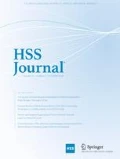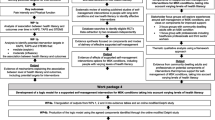Abstract
Background
Arthritis and other musculoskeletal diseases are the most prevalent health conditions in the USA, causing enormous financial and social burdens, especially in underserved communities. Targeted care and prevention programs are urgently needed.
Questions/Purposes
Within an overall goal of revealing health disparities, the questionnaire explored (1) the use of and access to healthcare, (2) the factors affecting quality of life, and (3) the levels of provider–patient communication.
Methods
A New York City musculoskeletal hospital conducted a community health needs survey among its diverse ethnic/racial communities. A 39-item questionnaire was administered online, by mail, and in person (in English, Spanish, and Chinese). Answers were analyzed in terms of sociodemographics, to define health disparities within a total sample and two subsamples.
Results
In the total sample, respondents were 60% White, 16% Black, 14% Hispanic/Latino, and 11% Asian, mostly female, and aged 50 to 79. More than 17% of the total sample indicated they could not access a healthcare provider when needed. Poor nutrition and lack of physical activity were large areas of concern, as were falls and poor self-reported health status. Nearly all respondents said they took steps to communicate with their healthcare providers. Dramatic health disparities were found between Whites and non-Whites (e.g., non-Whites were most likely to rate their health poorly, consider their diet fair or poor, lack health insurance, and be unable to access a healthcare provider).
Conclusion
The findings are being used to further refine, develop, and expand the hospital’s community programs, especially for culturally diverse and underserved communities.
Similar content being viewed by others
References
Alarcón GS, Calvo-Alén J, McGwin G Jr, LUMINA Study Group, et al. Systemic lupus erythematosus in a multiethnic cohort: LUMINA XXXV. Predictive factors of high disease activity over time. Ann Rheum Dis. 2006; 65: 1168-74.
Carroll W, Rhoades J. Access and experiences regarding healthcare: estimates for the US civilian non-institutionalized population aged 18 and older, 2010. Agency for Healthcare Research & Quality. Statistics Brief #466. Washington, DC: U.S. Department of Health and Human Services; 2013.
Centers for Disease Control and Prevention. Healthy People 2020. 2013. http://www.healthypeople.gov/2020/topicsobjectives2020/overview.aspx?topicid=3. Accessed 6 Jan 2014.
Centers for Disease Control and Prevention. National and state expenditures and lost earnings attributable to arthritis and other rheumatic conditions—United States, 2003. MMWR. 2007; 56: 4-7.
Centers for Disease Control and Prevention. Prevalence of doctor-diagnosed arthritis and arthritis-attributable activity limitation—United States, 2007–2009. MMWR. 2010; 59: 1261-5.
Committee on Understanding and Eliminating Racial and Ethnic Disparities in Healthcare, Board on Health Sciences Policy, Institute of Medicine, Smedley BD, Stith AY, Nelson AR, eds. Unequal treatment: confronting racial and ethnic disparities in healthcare. Washington, DC: National Academy Press; 2002.
Hootman JM, Helmick CG. Projections of US prevalence of arthritis and associated activity limitations. Arthritis Rheum. 2006; 54: 226-9.
Hughes DL. Quality of health care for Asian Americans. New York, NY: The Commonwealth Fund; 2002. Pub. #525.
Johnell D, Kanis JA. An estimate of the worldwide prevalence and disability associated with osteoporotic fractures. Osteoporosis Int. 2006; 17: 1726.
Kleinman J, Horton R, Seehaus M. A hospital-based program to address health disparities among culturally diverse older adults. In: Proceedings of the aging in America national conference (ASA), Chicago, IL, March 2010.
Kleinman J, Gonzalez M, Horton R, Seehaus S. Culturally sensitive care: focus group lessons VOICES 60+ senior advocacy program. In: Proceedings of the aging in America national conference on aging (NCOA/ASA), Las Vegas, NV, March 2009.
Lubeck DP. The costs of musculoskeletal disease: health needs assessment and health economics. Best Pract Res Clin Rheumatol. 2003; 17: 529-39.
Martin LR, Williams SL, Haskard KB, DiMatteo MR. The challenge of patient adherence. J Ther Clin Risk Manag. 2005; 1: 189-99.
Mead H, Cartwright-Smith L, Jones K, Ramos G, Woods K, Siegel B. Racial and ethnic disparities in U.S. healthcare: a chartbook. New York, NY: The Commonwealth Fund; 2008.
Minkler M, Wallerstein N. Community-based participatory research for health: from process to outcomes. 2nd ed. San Francisco, CA: Jossey-Bass; 2008.
National Osteoporosis Foundation. What is osteoporosis? 2013. http://nof.org/articles/7. Accessed 6 Jan 2014.
New York City Department of Health and Mental Hygiene. Health of older New Yorkers. NYC Vital Signs, 8(4). 2010. http://www.nyc.gov/html/downloads/pdf/survey/survey-2010seniors.pdf. Accessed 6 Jan 2014.
New York City Department of Planning. NYC2010. Results from the 2010 census. Population growth and race/Hispanic composition. http:www.nyc.gov/html/dcp/pdf/census/census2010/pgrhc.pdf. Accessed 16 Jul 2014.
New York City Department of Health and Mental Hygiene. Health insurance coverage and did not get needed medical care. In: Community Health Survey data, 2011. https://a816-healthpsi.nyc.gov/SASStoredProcess/guest?_PROGRAM=%2FEpiQuery%2FCHS%2FchsX&year=2011&strat1=none&strat2=none&qtype=univar&var=nomedc2&crude=no. Accessed 6 Jan 2014.
Population Division, U.S. Census Bureau. Projections of the population by age and sex for the United States: 2010 to 2050. 2008. http://www.aoa.gov/aoaroot/aging_statistics/profile/2009/4.aspx. Accessed 6 Jan 2014.
Rose JA, Horton R, Picardo DM, et al. Implementation of a pilot nutrition education intervention for culturally diverse teens with lupus and their families in Hospital for Special Surgery’s Charla de Lupus/Lupus Chat® Teen and Parent Support Group. Arthritis Rheum. 2012; 64(suppl 10): S1014.
Sievänen H, Kannus P. Physical activity reduces the risk of fragility fractures. PLoS Med. 2007; 4: e222.
Sullivan LW. Musculoskeletal disparities and their impact on the health of the nation. The Sullivan Alliance. 2010. http://www.thesullivanalliance.org/forms/presentations/15_Movement-is-Life_09-08-10.pdf. Accessed 6 Jan 2014.
Tran M, Horton R, Yee A, Lockshin M. Lupus education for providers serving the Asian American community: Hospital for Special Surgery’s LANtern® (Lupus Asian Network) initiative. Arthritis Rheum. 2013; 65(suppl 10): S421-2.
Disclosures
The authors wish to thank Phyllis Tower and Titilayo Ologhobo, MPH, for assistance with manuscript preparation.
Conflict of Interest
Sandra Goldsmith, MA, MS, RD; Dana Friedman, MPH; Roberta Horton, LCSW, ACSW; Mavis Seehaus, MS, LCSW; and Laura Robbins, DSW, have declared that they have no conflict of interest.
Human/Animal Rights
This article does not contain any studies with human or animal subjects performed by the any of the authors.
Informed Consent
N/A
Required Author Forms
Disclosure forms provided by the authors are available with the online version of this article.
Author information
Authors and Affiliations
Corresponding author
Additional information
Level of Evidence: Socioeconomic Analysis Level II
Rights and permissions
About this article
Cite this article
Goldsmith, S., Friedman, D., Horton, R. et al. Creating Musculoskeletal Programs for Culturally Diverse, Underserved Communities: a Community-Based Participatory Research Survey. HSS Jrnl 10, 266–275 (2014). https://doi.org/10.1007/s11420-014-9413-9
Received:
Accepted:
Published:
Issue Date:
DOI: https://doi.org/10.1007/s11420-014-9413-9




